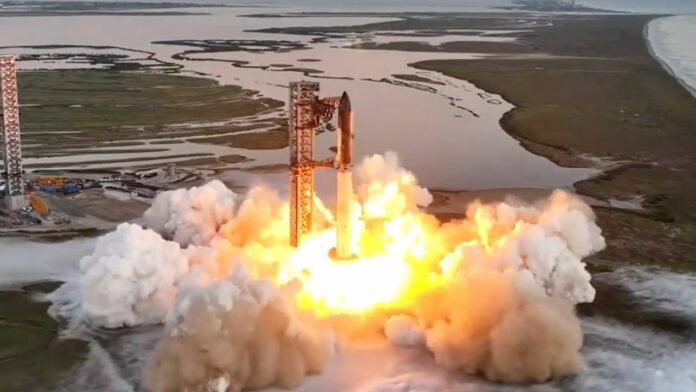Elon Musk’s ambitious rocket launch culminates in a successful booster catch and a dramatic upper-stage splashdown in the Indian Ocean
In a remarkable demonstration of innovation and engineering prowess, SpaceX successfully launched its Starship rocket on Sunday, marking a significant milestone in its quest for reusable space travel. The test flight, which took off from the Boca Chica starbase in southern Texas at 7.25 am local time (1325 BST), culminated in the company catching the massive booster stage with a pair of robotic arms, a feat described by many as “magical.”
This fifth test flight of the uncrewed Starship saw the 71-metre (233 ft) Super Heavy booster separate from the upper stage approximately 40 miles (65 km) above Earth. The upper stage then ascended to nearly 90 miles, completing a high-speed loop around the planet at an astonishing 17,000 mph before executing a planned splashdown in the Indian Ocean.
As the booster descended back to Earth, SpaceX personnel erupted in cheers and applause when it reignited three of its Raptor engines, expertly slowing its fall. The booster swung towards the “mechazilla” launch tower, where it was successfully caught by the giant metal arms—affectionately dubbed “chopsticks.” This marks a pivotal moment for SpaceX, which has long sought to develop fully reusable rockets capable of transporting humans and cargo to the Moon, and eventually Mars.
“Are you kidding me?” exclaimed Dan Huot, SpaceX’s communications manager, visibly shaken by the spectacular event. “What we just saw, that looked like magic.” Kate Tice, a quality systems engineer at SpaceX’s headquarters in Hawthorne, California, added, “This is a day for the engineering history books.”
The main Starship vehicle re-entered Earth’s atmosphere in a horizontal position, showcasing its advanced heat shielding during the process. Onboard cameras captured the impressive sight of a smooth, pinkish-purple plasma enveloping the ship’s Earth-facing side. With improvements made since its last test flight in June, where the ship suffered tile damage, this time the Starship appeared intact upon reigniting one of its six engines to right itself for the ocean landing.
The SpaceX live stream depicted the rocket splashing down in the dark waters off Australia’s coast, ultimately toppling onto its side. A subsequent camera feed from a nearby vessel captured the dramatic moment the ship exploded into a vast fireball, though it remains unclear whether this was a controlled detonation or the result of a fuel leak. Despite this, Musk proudly declared that the ship landed “precisely on target!”
The success of this mission has not gone unnoticed by the wider space community. Former Canadian astronaut Chris Hadfield took to X (formerly Twitter) to express his enthusiasm, stating, “There was an enormous step forward in human capability today. Makes me even more excited for our collective future. Congratulations to all at SpaceX!”
This latest achievement reinforces SpaceX’s position at the forefront of aerospace innovation. The ability to catch and reuse rocket boosters is a crucial step towards reducing costs and increasing the frequency of space launches, paving the way for a future where space travel becomes more accessible.
As SpaceX continues to refine its technologies and push the boundaries of what is possible, the company is setting the stage for humanity’s next great leap into the cosmos. With ambitions of colonising Mars and establishing a sustainable presence beyond Earth, every successful test flight brings us one step closer to turning science fiction into reality.
The path ahead is filled with challenges, but with each successful launch and landing, SpaceX is transforming the landscape of space exploration, one groundbreaking feat at a time.
